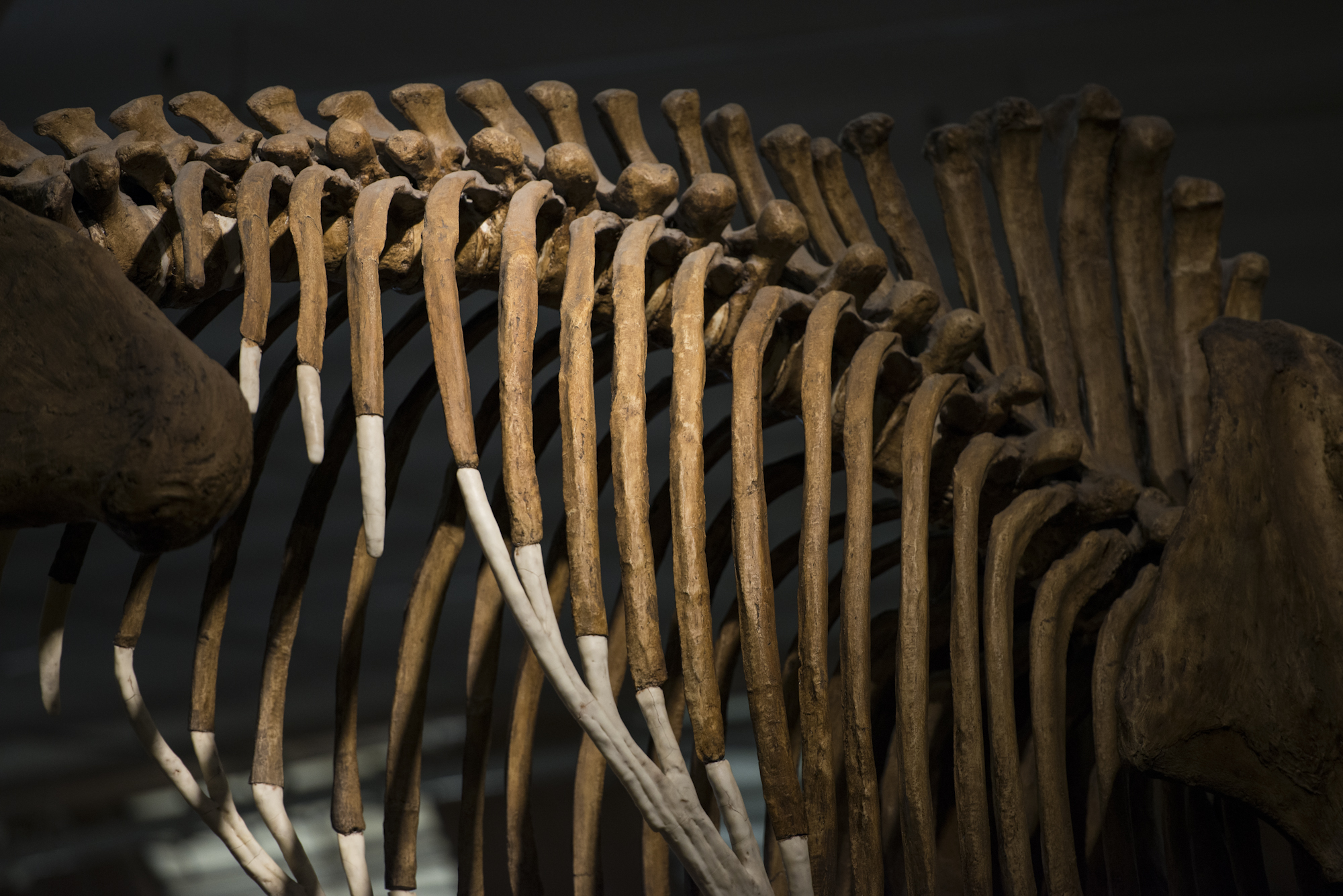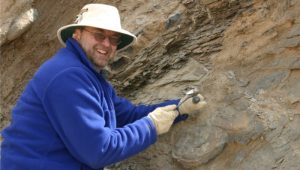
Vertebrate Paleontology
The Vertebrate Paleontology Department of Cincinnati Museum Center furthers scientific and historical knowledge by conducting an innovative, specimen-based, research program of national/international significance, and maintaining through reposited materials a database on global change and biodiversity from the perspective of the vertebrate fossil record. The Department develops the Museum’s vertebrate fossil collection and facilities, preserves for posterity a significant part of earth’s natural heritage, and makes information on the Department’s activities and resources available to the widest possible audience, both popular and professional.
Meet the Curator
Glenn W. Storrs, Ph.D.
Withrow Farny Curator of Vertebrate Paleontology
Phone: (513) 455-7164
Fax: (513) 287-7095
Email: gstorrs@cincymuseum.org
Biography

I joined Cincinnati Museum Center in 1995 and administer the education, research and collection management efforts and staff of the Museum of Natural History & Science. These include programs at Museum Center, the nearby Geier Collections and Research Center, The Richard and Lucile Durrell Edge of Appalachia Preserve System in Adams County, Ohio, and the Museum's Dinosaur Field School in Red Lodge, Montana. In my curatorial role, I oversee the Museum's fossil vertebrate research program and collections and am an international authority on the anatomy and evolution of fossil reptiles, particularly marine forms such as Sauropterygia.
I was born and raised in Poughkeepsie, New York, and was educated at Syracuse University, The University of Texas at Austin and Yale University. Before coming to Cincinnati, I was a Research Associate (later Visiting Senior Research Fellow) in the Department of Geology at the University of Bristol, England. I have led or joined numerous paleontological expeditions across North America, Europe, Asia and Africa. Ongoing projects close to home include work at significant localities in Ohio and Kentucky.
I have authored many scientific papers, book chapters and popular articles on fossil vertebrates, as well as two books for children. I am an active member of The Society of Vertebrate Paleontology, The Paleontological Society, The Geological Curators Group, The Systematics Association, and The Yellowstone - Bighorn Research Association. I was elected Fellow of the Linnean Society of London in 1993 and serve on numerous professional committees. I am a 2005 graduate of the Getty Foundation’s Museum Leadership Institute.
In addition to my role with Museum Center, I serve as adjunct professor of geology at the University of Cincinnati.
Education
- B.S., Geology & Biology, 1979, Syracuse University
- M.A., Geological Sciences, 1981, University of Texas at Austin
- Ph.D., Geology & Geophysics, 1986, Yale University
- Geology Research Associate, 1991-1995, University of Bristol
History of the Vertebrate Paleontology Collection
The collections were begun under the guidance of prominent Cincinnati physician Daniel Drake and The Western Museum Society in 1818 and continued by members of the Western Academy of Natural Sciences (1835), the Cincinnati Society of Natural History (1870) and the Cincinnati Museum of Natural History (1957). All of these institutions were predecessors and lineal ancestors of Cincinnati Museum Center. Samuel A. Miller was the first Curator of Paleontology of the Cincinnati Society of Natural History (1871-1874), followed by John W. Hall, Jr. (1874-1877), Edward O. Ulrich (1877-1880), John Mickelborough (1880-1884), Edward M. Cooper (1884-1885) and Charles L. Faber (1885-1886). A comprehensive Geology Department was established in 1889, but it was not until 1986, with the appointment of the first vertebrate paleontology curator (H. Gregory McDonald), that a separate Department of Vertebrate Paleontology was carved out of the general fossil collection. Glenn W. Storrs was appointed curator in 1995, and the position was permanently endowed by a generous community benefactor in 2009. The 1998 transfer of the University of Cincinnati paleontology collection (begun in 1907) to the Museum and an intensive program of research-oriented excavations created the lower Ohio Valley's largest vertebrate fossil collection, now numbering approximately 30,000 specimens (over 16,000 of which are currently catalogued on the Museum's KeEMu database server). The university collection includes specimens amassed by professors, students, and the Dry Dredgers Association of Amateur Geologists & Fossil Collectors, the oldest amateur paleontology society in the United States, founded in 1942. Noted vertebrate paleontologist Donald Baird was curator of the university collection from 1949 to 1951. The combined collection was moved to the Geier Collections and Research Center facility on Gest Street in 2001. In 2018, the University of Minnesota’s paleontology collection (established in 1872) was transferred to CMC, adding several thousand additional specimens to the VP collection.
Scope of the Vertebrate Paleontology Collection
The collection is particularly strong in local Pleistocene and Holocene fossils, including material from Big Bone Lick, Kentucky, the birthplace of American vertebrate paleontology. A large and important suite of late Wisconsinan specimens from Sheriden Pit, Wyandotte County, Ohio, was collected in the early 1990s. Also represented are significant Devonian and Carboniferous holdings, particularly from the Cleveland Shale and equivalents in Ohio and Kentucky, and the Hancock Site of western Kentucky, respectively.Other strengths include collections of Mesozoic marine vertebrates, particularly from the Middle Triassic of Nevada and the Niobrara Cretaceous of Kansas (including historical specimens from Charles H. Sternberg), a juvenile sauropod assemblage from the Morrison Formation Mother’s Day Site of Montana, Morrison dinosaurs and microvertebrate material from the Aaron Scott Site, Emery County, Utah, and from the Morrison of Moffat County, Colorado, the world’s only associated skeleton of Torvosaurus tanneri. The Robert Sloan collection of Hell Creek and Tullock microvertebrates contains many hundreds of Cretaceous/Paleogene mammal specimens, particularly from Bug Creek, McCone County, Montana. Articulated skeletons of Galeamopus and Daspletosaurus, and the Ken Caster/Donald Baird cast collection of vertebrate ichnofossils are also notable. Cast replicas of significant research and/or educational specimens held in other public collections are also maintained in the CMC collection, as well as a broad collection of comparative material from around the world. In addition to fossils, the department preserves associated contextual data (field notes, maps, photographs, correspondence, preparation history sheets, old exhibit and collection labels, and publications containing reference to specimens in the collection) related to the catalogued collection items. Pertinent data, including georeference information and digitized images, subject to security and ethical concerns, are made available in on-line digital format on an on-going basis. Specimens in the Museum's collection are available to qualified individuals for research and educational use by appointment.
Staff and Adjuncts
Cameron Schwalbach
Collections Manager
Cincinnati Museum Center
1301 Western Avenue, Cincinnati, OH 45203
Phone: 513-287-700 x6244
Email: cschwalbach@cincymuseum.org
Brooke Crowley, Ph.D.
Professor
Department of Geosciences
503 Geology-Physics Building
University of Cincinnati
Cincinnati, OH 45221
Phone: 513-556-7181
Email: crowlebk@ucmail.uc.edu
Takuya Konishi, Ph.D.
Assistant Professor
Department of Biological Sciences
851R Rieveschl Hall
University of Cincinnati
Cincinnati, OH 45221
Phone: 513-556-9726
Email: konishta@ucmail.uc.edu
Joshua Miller, Ph.D.
Assistant Professor
Department of Geosciences
509 Geology-Physics Building
University of Cincinnati
Cincinnati, OH 45221
Phone: 513-556-6704
Email: mille5ju@ucmail.uc.edu
Ryan Shell, Ph.D.
Paleontologist
Huron-Manistee National Forest
1755 Mitchell Street
Cadillac, MI 49601
Phone: 231-942-4707
Email: ryan.shell@usda.gov
Big Bone Lick Publications, 1744-2022
Big Bone Lick is a Kentucky State Historic Site located 20 miles southwest of Cincinnati.
